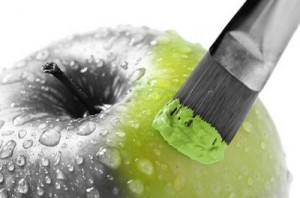Did you know that approximately fifteen million pounds of artificial coloring is included in foods each year? This startling information makes the recent reports on the dangers of food dyes even more unsettling. The Center for Science in the Public Interest (CSPI) recently published the report “Food Dyes: A Rainbow of Risks” detailing how unsafe it is to include these artificial ingredients in our food supply.
You’ll most often find artificial food colorings in products geared towards children, as manufacturers attempt to make the food more appealing to their eyes. However, these artificial colors have been linked to behavior problems like hyperactivity in children, as well as allergies. European food manufacturers are now required to add a warning label to products containing certain artificial coloring that they “may have an adverse effect on activity and attention in children”.
There’s even evidence to suggest that some dyes – Blue 1, Blue 2, Green 3, and Red 40 can cause cancer in animals. Major food dyes to look out for include Red 40, Yellow 5, and Yellow 6, which are the three most commonly used and known to be carcinogenic (contributing to the causes of cancer). The CSPI has called for the Food and Drug Administration (FDA) to ban food dyes, forcing manufacturers to instead turn to real food to color foods (think beet juice).
To quote CSPI executive director Michael F. Jacobson, “These synthetic chemicals do absolutely nothing to improve the nutritional quality or safety of foods, but trigger behavior problems in children and, possibly, cancer in anybody.”
What YOU Can Do:
- Choose to color your plates naturally with the wonderful colors found in nature – red tomatoes, leafy greens, and sweet potatoes. Check out my blog on colorful fruits and vegetables here!
- Stick to real, clean foods that are as close to nature as possible. This means lots of fresh fruits and veggies instead of artificially colored treats.
- Always, always, always read labels on the products you buy. Look out for the artificial colors listed above in yogurts, cereals, cookies and snack foods to ensure you’re being a savvy shopper.
- Stay updated on this issue – it’s important to remain aware of what’s going on in our food supply!
Assistance provided by Megan Skinner










I’ve never been a fan of food dyes because they aren’t naturally present in food. I’m just wondering why this isn’t a priority to get these off the GRAS list? It’s really disheartening.